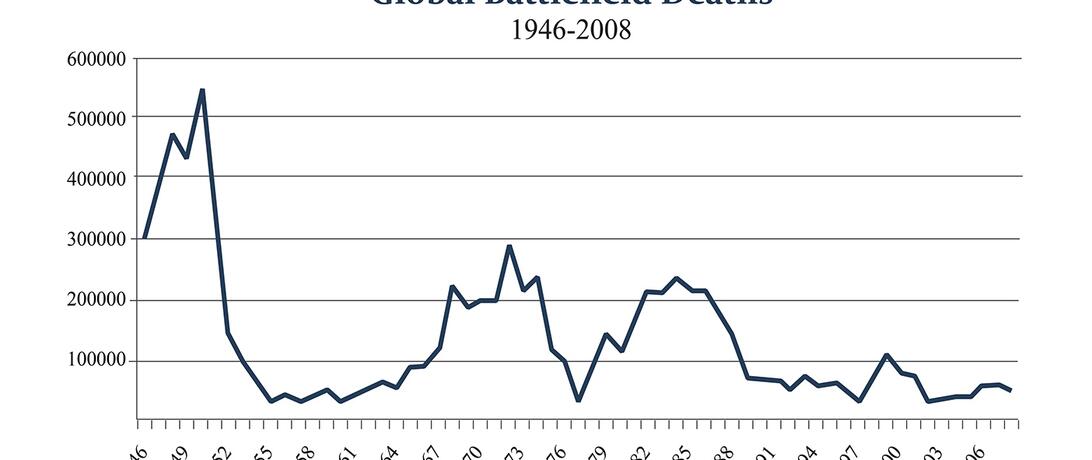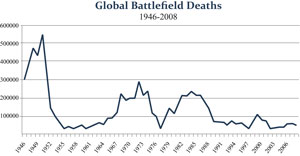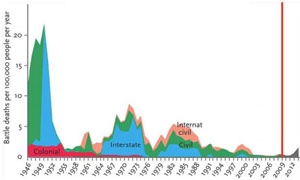
This blog post briefly reviews the current state of research on armed conflict, discusses the predictors of peace, and addresses the opportunities for OEF, dedicated to fostering sustainable peace.
Is the world getting more peaceful? A brief overview of relevant research
This blog post briefly reviews the current state of research on armed conflict, discusses the predictors of peace, and addresses the opportunities for One Earth Future, which is dedicated to leading the initiatives that aim to improve systems that prevent and stop armed conflict.
 Is the world getting more peaceful?
Is the world getting more peaceful?
The short answer to this question is yes. Recent research has consistently shown trends toward fewer and less lethal wars over time. This trend is most visible when looking at interstate conflict in the 20th century, which has decreased dramatically since the late 1940s. The story for intrastate conflict, such as rebellions and insurgencies, is more complicated: The number of such conflicts in the world today is higher than at the turn of the century, although not as high as it was during the Cold War. Despite the increased intrastate conflict over the same time period, the number of battlefield deaths per year has been trending downward over time (see left). Steven Pinker has argued that more than this, over the past 10,000 years of recorded human history the trend has been towards a more and more peaceful world when considering all forms of violence rather than just war – a claim supported by other researchers.
What might explain this trend?
A number of factors have been found to be associated with increased peace. At the intrastate level, increased trade and economic engagement, the spread of democracy, and increasing gender equality have all been identified as important predictive factors of peace. The increasing role of the UN in providing active peacekeeping forces has been identified as important for both inter- and intra-state conflict, while education and increasing global prosperity have also been identified as critical reasons for the increase in state stability internationally.
 What about current wars and apparent increase of violence recently?
What about current wars and apparent increase of violence recently?
This is an important point. Even if the world is getting more peaceful overall, many people are still suffering from violence today. However, there are two reasons we continue to make the claim that the world is getting more peaceful:
- There is evidence of an increase in battle-related deaths in 2013, and it’s likely that there will be another increase in 2014. Despite these increases the world is not approaching the level of violence seen in the 1990s, or during the Cold War. The decline in battle-related deaths and increase in fundamental drivers of peace have been so profound over the 20th century that the increase in violence over the past two years does not reverse the gains made. It’s likely that any year-to-year variation will trend towards reduced violence.
- Furthermore, the underlying trends that support peace – economic development, education, women’s empowerment, global trade, and improved governance internationally – do not appear to be withdrawing from the gains made throughout the 20th centuries.
What is OEF’s Role?
The decline in conflict throughout the 20th Century highlights an important opportunity for those engaged in issues of global governance. Through our initiatives, One Earth Future Foundation seeks to further support the continuation of positive global trends and provide active operational, research, and strategic support to creating constructive alternatives to violent conflict.
Article Details
Published
Topic
Program
Content Type
Opinion & Insights